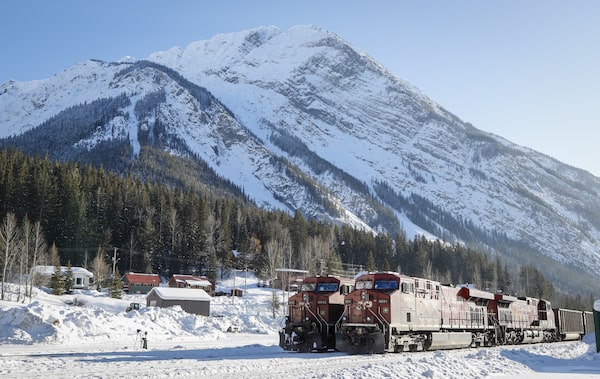
Eastbound trains wait in Field, B.C., after a Canadian Pacific freight train fell more than 60 metres from a bridge near the Alberta-British Columbia boundary in a derailment that killed three crew members in February. (File Photo).Jeff McIntosh/The Canadian Press
Canada’s rail-safety investigator has urged the government to review the way brakes on grain-hopper cars are inspected and maintained in the wake of a fatal runaway train crash near Field, B.C. The Transportation Safety Board also called for greater use of handbrakes on trains that have made emergency stops.
The TSB issued the advisories as part of its investigation into the crash of Canadian Pacific Railway Ltd. Train 301, a 112-car grain train that rolled away after having made an emergency halt on a steep grade, sped out of control down a slope in the Rocky Mountains, jumped the tracks and killed its three-man crew on Feb. 4.
TSB investigators said no handbrakes were set on the rail cars. That meant the crew was relying on the cars’ air brakes to hold the train in place. Air brakes are known to leak and be unreliable in cold and snowy conditions.
“In most operating scenarios, some leakage is expected and it will not initially compromise safety,” the TSB said in its advisory to Transport Canada. “However, it can create a reduced margin of safety when a train brake system is relied upon for an extended duration.”
The TSB said the 13 cars that did not derail failed a brake test conducted as part of the investigation. “The air brake system on these cars would not provide adequate braking effectiveness to ensure the safe operation of a loaded unit grain train in a situation where the air brakes are required to remain applied for an extended duration, such as while descending a steep grade,” Kirby Jang, a TSB director, said in a letter to Transport Canada, posted on the TSB’s website.
The TSB issues advisories, which are not binding, to highlight unsafe conditions and to reduce safety risks.
Train 301 had made an emergency stop on the steep grade after its crew was unable to control its speed. Around 1 a.m., a relief crew had just boarded the train, which had sat for three hours in -28 C. The train began moving on its own and quickly exceeded the 31-kilometre-an-hour speed limit on the tracks and plunged down the mountainside at a bridge, investigators said.
The crash killed engineer Andrew Dockrell, conductor Dylan Paradis and trainee Daniel Waldenberger-Bulmer. The lead locomotive was found in the Kicking Horse River, more than 60 metres below the tracks.
Railroaders know grain trains have poor brakes, said Greg Edwards, an official with Teamsters Canada Rail Conference, the union that represents workers at CP and other railways. He said this is because the systems of gaskets, pipes and tanks are prone to bleeding air, which reduces or eliminates their stopping power.
Much of Canada’s hopper-car fleet is decades old and being replaced. CN and CP last year announced plans to spend hundreds of millions of dollars on new cars to haul what is a major export commodity.
Mr. Edwards believes the TSB wants Transport Canada to conduct more air-leakage tests, something that is usually done car by car when a train is in a service shop.
CP has had at least three major derailments on the tracks west of Calgary this year, after a year in which the industry’s safety record declined. In 2018, derailments, deaths and other major incidents rose by 7 per cent on Canada’s railways from the year earlier.
The spike prompted Transport Minister Marc Garneau to reprimand both of the country’s major railways, Canadian National Railway Co. and CP, in a letter this month. “The number of fatalities and serious injuries of railway personnel that have occurred in the last two years remains too high,” Mr. Garneau wrote.
In response to an increase in the amount of dangerous goods moving on some routes, Transport Canada is “intensifying” inspections of mainline tracks, Mr. Garneau said.
Shortly after the crash of Train 301, Mr. Garneau ordered all railways to apply handbrakes on trains that made emergency stops on “mountain grades” of 1.8 per cent or greater. Train 301 was on a grade of 2.2 per cent. The TSB advisory calls for handbrakes to be used on “heavy” grades as well, which are slopes of between 0.8 per cent and 1.8 per cent.
The rail industry pushed back against the Garneau order in meetings with Transport Canada officials. CP, CN and the Railway Association of Canada in March launched appeals of the order with the Transportation Appeal Tribunal. Those appeals will be heard in May.
Setting and releasing handbrakes is a slow, physically demanding task, a step railways are loathe to take in order to not occupy a track and block traffic.
CP said on Thursday it is reviewing the TSB advisories and is “fully complying" with Transport Canada’s order on handbrakes. ”CP has taken steps to further enhance safety by supplementing its existing protocols for train operations across the network," company spokesman Jeremy Berry said.
CN declined to comment.
The TSB said its investigation into the fatal Feb. 4 crash continues.
The probe, which will pinpoint causes and contributing factors, is focused on weather conditions and CP’s operating plan; train operations on the track known as Field Hill; operations policies on mountain grades; crew training on the reliability of air brakes in extremely cold weather; maintenance history of the rail cars.
The investigation is expected to be complete within 600 days of its launch, the TSB said.
Data from the lead locomotive’s event recorder, or black box, were not found owing to the severity of the damage, the TSB said. Data were found on the recorders in the two mid-train and tail-end engines.
 Eric Atkins
Eric Atkins